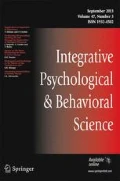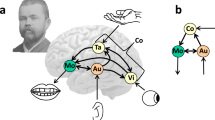Abstract
The role of “subvocalization” during language comprehension, especially reading, is examined. Four arguments against it having a role in accessing memory are erroneous because 1) its latencyis much shorter than is conventionally stated; 2) rate of visual information processing is erroneously estimated by failing to distinguish between reading and scanning; 3) covert speech doesnot disappear in the competent language performer; and 4) the argument that subvocalization is an epiphenomen is irrelevant. Rather, data support the generalization that covert speech is present during all cognitive functioning and that its specific topography is discriminatively related to the class of phoneme being processed. It is thus inferred that during cognition the speech musculature generates a phonetic code that may function to access linguistic memory. However, since there are also numerous other psychophysiologic events associated with covert speech, a multichannel processing system is hypothesized wherein speech, visual, and kinesthetic modalities interact with the brain. Illustrations are given of how this accessing model is compatible with existing holographic and feature analyzer models of memory. Data are presented that illustrate how phonetically encoded neuromuscular events can be directly measured through psychophysiologic methods. It is hypothesized that cognitive processes are generated when cybernetic neuromuscular circuits selectively interact. Consequently,all components of these neuromuscular circuits serve a function during cognition so that a role for “subvocalization” (a muscular component) cannot be ruled out in anapriori manner.
Similar content being viewed by others
References
Anderson, J. A., Silverstein, J. W., Ritz, S. A., and Jones, R. S. Distinctive features, categorical perception, and probability learning: Some applications of a neural model.Psychological Review, 1977,84, 413–451.
Baddeley, A. D., and Hitch, G. Working memory. In G. H. Bower (Ed.),The Psychology of learning and motivation, 8. New York: Academic Press, 1974.
Beurle, R. I. Properties of a mass of cells capable of regenerating pulses.Philosophical Transactions of the Royal Society, 1956,240, 55–94.
Blumenthal,J. Lingual Myographic Responses During Directed Thinking. Unpublished doctoral dissertation, University of Denver, 1959.
Burgess, P. R., Wei, J. Y., Clark, F. J., and Simon, J. Signaling of kinesthetic information by peripheral sensory receptors.Annual Review of Neuroscience, 1982,5, 171–187.
Cacioppo, J. T., and Petty, R. E. Electromyograms as measures of extent and affectivity of information processing.American Psychologist, 1981a,36, 441–456.
Cacioppo, J. T., and Petty, R. E. Electromyographic specificity during covert information processing.Psychophysiology, 1981b,18, 518–522.
Chapman, R. M., McCrary, J. W., and Chapman, J. A. Short-term memory: The “storage” component of human brain responses predicts recall.Science, 1978,202, 1211–1214.
Davis, R. C. Patterns of muscular activity during “mental work” and their constancy.Journal of Experimental Psychology, 1939,24, 451–465.
Davis, W. B.Perceptual Difficulty, Perceptual Salience and Covert Oral Responses. Unpublished doctoral dissertation, University of Louisville, 1983.
Duncan-Johnson, C. C. P300 latency: A new metric of information processing.Psychophysiology, 1981,18, 207–215.
Estes, W. K. The Bible is out. Review of Woodworth, R. S.Experimental Psychology, New York: Holt, 1938.Contemporary Psychology, 1981,26, 327–330.
Faaborg-Anderson, K., and Edfelt, A. W. Electromyography of intrinsic and extrinsic laryngeal muscles during silent speech: Correlation with reading activity.Acta oto-laryngologica, 1958,49, 478–482.
Fisher, S. Body awareness and selective memory for body versus nonbody references.Journal of Personality, 1964,32, 138–144.
Fisher, S. Influencing selective perception and fantasy by stimulating body landmarks.Journal of Abnormal Psychology, 1972,79, 97–105.
Foss, D. J., and Hakes, D. T.Psycholinguistics: An Introduction to the Psychology of Language. Englewood Cliffs, N. J.: Prentice-Hall, 1978.
Foulke, E., and Sticht, T. G. Review of research on the intelligibility and comprehension of accelerated speech.Psychological Bulletin, 1969,72, 50–62.
Gallo, D. R.National Assessment of Educational Progress: Reading Rate and Comprehension 1970–81 Assessment (Education Commission of the States NO 02-R-09). Washington, D. C.: U.S. Government Printing Office, 1972.
Guttentag, R. E. A comment on “phonological recoding and reading.”Psychological Bulletin, 1982,91, 366–368.
Harris, A.J. How to Increase Reading Ability. New York: Longmans, Green & Co., 1947.
Jacobson, E. Imagination and recollection of various muscular acts.American Journal of Physiology, 1930,94, 22–34.
Jacobson, E. Electrical measurements of neuromuscular states during mental activities. VII. Imagination, recollection and abstract thinking involving the speech musculature.American Journal of Physiology, 1931,97, 200–209.
Jakobson, R., and Halle, M.Fundamentals of Language (2nd rev. ed.). The Hague, Netherlands: Mouton, 1971.
John, E. R. Switchboard versus statistical theories of learning and memory.Science, 1972,177, 850–864.
Julesz, B., and Pennington, K. Equidistributed information mapping—an analogy to holograms and memory.Journal of the Optical Society of America, 1965,55, 604.
Just, M. A., and Carpenter, P. A. Eye fixations and cognitive processes.Cognitive Psychology, 1976,8, 441–480.
Keen, S. My new carnality.Psychology Today, 1970,4, 59–61.
Kleiman, G. M. Speech recoding in reading.Journal of Verbal Learning and Verbal Behavior, 1975,14, 323–339.
Landauer, T. K. Rate of implicit speech.Perceptual and Motor Skills, 1962,15, 646. In F. J. McGuigan (Ed.),Thinking: Studies of Covert Language Processes. New York: Appleton-Century-Crofts, 1966.
Lashley, K. In search of the engram. InSymposia: Society for Experimental Biology. New York: Academic Press, 1950, pp. 454–482.
Locke, J. L., and Fehr, F. S. Subvocal rehearsal as a form of speech.Journal of Verbal Learning and Verbal Behavior, 1970,9, 495–498.
Longuet-Higgins, H. C. The non-local storage and associative retrieval of spatio-temporal patterns. In K. N. Leibovic (Ed.),Information Processing in the Nervous System. New York: Springer-Verlag, 1969.
McCusker, L. X., Hillinger, M. L., and Bias, R. G. Phonological recoding and reading.Psychological Bulletin, 1981,89, 217–245.
McGuigan, F.J.Thinking: Studies of Covert Language Processes. New York: Appleton-Century-Crofts, 1966a.
McGuigan, F. J. Covert oral behavior and auditory hallucinations.Psychophysiology, 1966b3, 73–80.
McGuigan, F. J. Feedback of speech muscle activity during silent reading.Science, 1967,157, 579–580.
McGuigan, F. J. Covert oral behavior during the silent performance of language tasks.Psychological Bulletin, 1970,74, 309–326.
McGuigan, F. J. External auditory feedback from covert oral behavior during silent reading.Psychonomic Science, 1971,25, 212–214.
McGuigan, F. J. The function of covert oral behavior (“ silent speech”) during silent reading.International Journal of Psycholinguistics, 1973a,2, 39–47.
McGuigan, F. J. Conditioning of covert behavior: Some problems and some hopes. In F. J. McGuigan and D. B. Lumsden (Eds.),Contemporary Approaches to Conditioning and Learning. Washington, D. C.: V. H. Winston & Sons, 1973b.
McGuigan, F.J.Cognitive Psychophysiology—Principles of Covert Behavior. Englewood Cliffs, N. J.: Prentice-Hall, 1978 (now published by Lawrence Erlbaum Associates, Hillsdale, N. J.).
McGuigan, F. J.Psychophysiological Measurement of Covert Behavior—aGuide for the Laboratory. Hillsdale, N. J.: Lawrence Erlbaum Associates, 1979a.
McGuigan, F. J.Calm Down: a Guide to Stress and Tension Control. Englewood Cliffs: Prentice-Hall, 1981.
McGuigan, F. J. Electrical measurement of internal information processing during silent reading and listening.The Pavolvian Journal of Biological Science, 1979b,14, 218–225.
McGuigan, F. J. Is verbal behavior confined to the speech apparatus?The Pavlovian Journal of Biological Science, 1983,18, 216–217.
McGuigan, F. J., and Bailey, S. C. Longitudinal study of covert oral behavior during silent reading.Perceptual and Motor Skills, 1969,28, 170.
McGuigan, F. J., and Boness, D. J. What happens between an external stimulus and an overt response? A study of covert responses.Pavlovian Journal of Biological Science, 1975,10, 112–119.
McGuigan, F. J., Culver, V. I., and Kendler, T. S. Covert behavior as a direct electromyographic measure of mediating responses.Conditional Reflex, 1971,6, 145–152.
McGuigan, F. J., Dollins, A., Pierce, W., Lusebrink, V., and Corus, C. Fourier analysis of covert speech behavior.The Pavlovian Journal of Biological Science, 1982,17, 49–52.
McGuigan, F. J., and Pavek, G. V. On the psychophysiological identification of covert nonoral language processes.Journal of Experimental Psychology, 1972,92, 237–245.
McGuigan, F. J., and Pinkney, K. B. Effects of increased reading rate on covert processes.Interamerican Journal of Psychology, 1973,7, 223–231.
McGuigan, F. J., and Winstead, C. L., Jr. Discriminative relationship between covert oral behavior and the phonemic system in internal information processing.Journal of Experimental Psychology, 1974,103, 885–890.
Novikova, L. A. Electrophysiological investigation of speech. Conference on Psychology, 1–6 July, 1955. In N. O’Connor (Ed.),Recent Soviet Psychology. New York: Pergamon Press, 1961, pp. 337–351.
Osgood, C. E. Where do sentences come from? In D. Steinberg and L. Jakobovits (Ed.),Semantics. New York: Cambridge University Press, 1971.
Osgood, C. E., and McGuigan, F. J. Psychophysiological correlates of meaning: Essences or tracers? In F. J. McGuigan and R. A. Schoonover (Eds.),The Psychophysiology of Thinking. New York: Academic Press, 1973.
Persson, A., Leanderson, R., and Ohman, S. Electromyographic studies of facial muscle activity in speech.Electroencephalography and Clinical Neurophysiology, 1969,27, 725.
Pribram, K. H.Languages of the Brain: Experimental Paradoxes and Principles in Neuropsychology. Englewood Cliffs, N. J.: Prentice-Hall, 1971.
Pritchard, W. S. Psychophysiology of P300.Psychological Bulletin, 1981,89, 506–540.
Rahimi, M. A., and Friedlander, C. B. Linguisitic significance of myoelectric activities of lip musculature.Institute of Electrical and Electronics Engineering, Frontiers of Engineering in Health Care, 1980,1, 301–304.
Rorschach, H.Psychodiagnostics. (translation by P. Lemkau and B. Kronenburg). Bern: Verlag Hans Huber, 1942.
Sanquist, T. E., Rohrbaugh, J. W., Syndulko, K., and Lindsley, D. B. Electrocortical signs of levels of processing: Perceptual analysis and recognition memory.Psychophysiology, 1980,17, 568–576.
Schutz, W., and Turner, E.Evy: An Odyssey into Body-Mind. New York: Harper & Row, 1976.
Siegenthaler, B. M., and Hochberg, I. Reaction time of the tongue to auditory and tactile stimulation.Perceptual and Motor Skills, 1965, 21, 387–393.
Sokolov, A. N.Inner Speech and Thought. New York: Plenum Press, 1972.
Spoehr, K. T. Word recognition in speech and reading: Toward a single theory of language processing. In P. Eimas and J. Miller (Eds.),Perspectives on the Study of Speech. Hillsdale, N. J.: Lawrence Erlbaum Associates, 1981.
Stevens, K. N., and Blumstein, S. E. The search for invariant acoustic correlates of phonetic features. In P. D. Eimas and J. Miller (Eds.),Perspectives on the Study of Speech. Hillsdale, N. J.: Lawrence Erlbaum Associates, 1981.
Sussman, H. M. What the tongue tells the brain.Psychological Bulletin, 1972,77, 262–272.
Taylor, E. A.Controlled Reading. Chicago: University of Chicago Press, 1937.
Titchener, E. B.Lectures on the Experimental Psychology of the Thought-Processes. New York: Macmillan, 1909.
Young, D. A. Cross-modal convergence and language. Proceedings of the 11th World Congress of Neurology, Amsterdam, September 11–16, 1977, Excerpta Medica.
Werner, H., and Wapner, S. Sensory-tonic field theory of perception.Journal of Personality, 1949,18, 88–107.
Author information
Authors and Affiliations
Additional information
Invited Address, American Psychological Association Meetings, Los Angeles, California, 1981.
Appreciation is expressed to Meredith Richards and to Charles Osgood for critically reviewing the manuscript for this article.
Rights and permissions
About this article
Cite this article
McGuigan, F.J. How is linguistic memory accessed? A psychophysiological approach. Pav. J. Biol. Sci. 19, 119–136 (1984). https://doi.org/10.1007/BF03003585
Issue Date:
DOI: https://doi.org/10.1007/BF03003585




